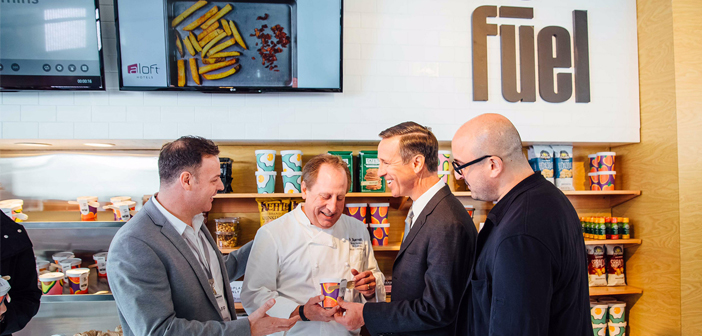As trends and fads come and go, so too do amenities in the hotel industry.
By Alicia Hoisington
Not always was hotel breakfast a mainstream concept, but now it’s difficult to find a hotel without the offering. Not long ago fax machines adorned guestrooms, then iPads, and now it’s all about BYOD – bring your own device. With guest wants and needs constantly changing, some hoteliers might find it difficult to know what to invest in. But what is clear today is that guest wants are changing, and hoteliers need to adapt amenities to meet their needs.
Experiencing amenities
Experiential travel continues to gain traction and hotels continue to adapt, says Toni Stoeckl, global brand leader and vice president of distinctive select brands at Marriott International.
Part of that guest experience is shared through communal public spaces, he says. That’s why many hotels now offer lobbies or other public areas that encourage togetherness.
“Guests want to be alone together,” Stoeckl says. “Even if they don’t want to interact with anyone, they want to be in that space with them.”
Marriott earlier this year launched its first pop-up hotel innovation lab to receive real-time feedback from the public. With this lab, the brand company introduced new concepts for two of its most innovative brands, Aloft and Element, which Marriott obtained after its acquisition of Starwood Hotels & Resorts Worldwide.
The Element brand is piloting a new guestroom design that features a communal room in the middle of four guestrooms, which will allow travelers to share a kitchen, dining area and lounge.
Meanwhile, the Aloft brand has become known for its communal bar area and Live at Aloft program, which features local artists performing in the hotel’s lounge.
Joseph S. Khairallah, president and chief operating officer at Marcus Hotels & Resorts, agrees that social spaces are a trend that will continue in the near future.
“We see a trend where club lounges are disappearing and more people want communal tables versus having that elite attitude,” he says. “People are more and more into congregating together and socializing, so we are seeing every lobby and public space turned into a socialized place and the seating in hotels is changing to become more interactive.”
Food and beverage evolution
Much of the guest experience comes from food and beverage amenities that hoteliers now offer, and sources say F&B will only continue to evolve as more and more travelers clamor for unique experiences.
“In general, food and beverage is part of the guest experience that’s getting elevated,” Stoeckl says, adding that guests are more passionate about what they are eating on the road than they have ever been before.
“We know that food and beverage is an experience to customers, and they’re looking for what I call a heartbeat,” says David Morgan, vice president of food and beverage for Omni Hotels & Resorts. “It’s a way to keep our engagement with the customer on an ongoing basis.”
That’s why Omni launched its “Omni Originals” culinary and cocktail program, which offers guests a taste of a themed food and beverage each quarter that showcases the hotel brand’s regional culinary talent. In February, the program kicked off with a soup theme as a nod to National Homemade Soup Day. In May, Morgan says sliders made an appearance, with lobster sliders from New England and hot chicken sliders from Nashville.
“We try to do items that are good for you,” Morgan says. “We also take into account national or regional trends, and by doing these types of programming, we validate those trends.”
Sources say wellness trends in F&B are here to stay in the types of amenities hotels offer.
“The days of high fructose corn syrup and tons of sugar are gone,” Morgan says. “We often say things that taste good can also be good for you.”
Stoeckl agrees, citing both the Aloft and Element brands as focusing on health and wellness. Aloft, for one, is revitalizing its F&B program with a focus on fresh and healthy ingredients such as spinach, quinoa and avocado. Guests will be able to order customized “pots,” or healthy meals, in to-go containers that reflect regional tastes.
Local sourcing of food at hotels also will continue to become more mainstream as guests demand it from their stay experience, Khairallah says.
“A lot of hotels are partnering with local purveyors and farmers and seeking homegrown seasonal produce,” he says, adding that hotels are offering personalized, unique activities such as private experiences with regional vineyards, deep-sea fishing excursions and mixology classes to spice up F&B amenities.
“The industry is moving toward personalization. What do you like? What do you want? We got it for you,” Khairallah says. “In the past, it was cookie cutter where everything is the same, and that’s starting to move away.”
Morgan agrees. “When I was younger people were afraid; they’d go to the hotel and they’d eat in the hotel. They just didn’t want to venture out. Now through social media, through the Food Network, now people go with the expectation of having a local, authentic experience.
“We take that to heart. We believe that’s a trend that will stay,” he says.
Morgan and Khairallah say that chefs are playing a big role in F&B amenities and will continue to do so moving forward.
“Because people want truly local food, we will see more local chefs partnering with hotels to ensure the authenticity of the food,” Morgan says.
Khairallah says chefs are popular at properties, and many hotels are starting to offer “meet the chef” sessions where guests can sit at a chef’s counter and become part of the experience during a private dinner.
“They are watching and learning from the chef,” he says. “You put a chef with a group of customers, and the limelight will be stolen. People want to experience and learn.”
And brands like Element are marrying technology and F&B amenities to add to the guest experience. As part of its innovation lab showcase, Marriott introduced the new concept of a portable wine cart that automatically will pour a glass of wine when a guest activates it using his or her hotel room key card.
Technology grows amenities
Hotel technology is becoming more intertwined with the guest experience as hoteliers look to meet guest demands in an ever-growing marketplace.
Beyond the obvious need for fast Wi-Fi, guests want more technology at hotels. The new rule of thumb is that they want at least what they have at home, if not better, sources say.
Therefore, on-demand services are falling by the wayside while personalization becomes key, Khairallah says. Guests travel with their own devices and content. Gone are the days of such services as pay per view, and here to stay is the offering of streaming content such as Netflix, Hulu and Amazon Video using personal accounts with hotel TVs.
Stoeckl says streaming content is a big focus for Marriott as well.
“We want to ensure that guests can extend their technology and their content in the room,” he says. “In our brands, you can watch your own content.”
Khairallah says mobile technology is a way of life, and hoteliers have been adapting to the fact that guests travel with multiple mobile devices everywhere they go. Thus, mobile check-in and keyless entry will only continue to grow.
“In our branded hotels, we have invested money in our locks so we can move toward the digital key that Hilton has made a big investment behind,” he says. “And this is just checking in online, and going up straight to your room and pointing your mobile device at the lock, and it recognizes your lock and your room number and unlocks the door for you.”
He says keyless entry via mobile device is a big advantage for guests who are pressed for time and want to bypass the front desk. However, he notes that brands are still trying to tweak the technology to make it seamless to meet guest needs. For example, if a guest has someone staying in the room as well and that person doesn’t have the mobile app downloaded, an old-fashioned key will be needed.
“Everyone is pressed for time these days and everyone is attached to their mobile device, so those two recipes create these kind of trends,” Khairallah says, adding that with this technology comes the ability for guests to choose their own room via mobile app.
Even though Khairallah says this amenity will become more prevalent in the industry, he doesn’t ever see the need for the human touch to disappear.
“At the end of the day we’re in the hospitality business, but there’s a certain segment of the population that loves things like that,” he says.
Khairallah says voice-controlled guestrooms also will be seen more throughout the industry. With this technology, guests will be able to control the thermostat, lights and other aspects of the room by simply telling the room what to do.
“These rooms would give the opportunity to control the hotel experience with a certain level of personal innovation,” he says. “It hasn’t become mainstream yet because it requires a significant investment in technology, but we see that as something starting to happen.”
In August, the Aloft Boston Seaport debuted rooms equipped with Apple’s Siri technology in its Project Jetson pilot program. Stoeckl says about 10 rooms were outfitted with the technology that allows guests to control everything in the room — from lighting to temperature — by the sound of their voices.
“It’s all about leveraging technology to make the experience seamless, but none of that is interfering with the Wi-Fi access to make sure guests can use their own tech, too,” Stoeckl says.
Creative programming
Technology also is playing a role in other amenity areas, particularly when it comes to creative programming at hotels.
At the Pfister Hotel in Milwaukee, an Artist in Residence program has become popular with guests and the local community, Khairallah says. Local artists are invited to apply to the program and dedicate time to the property through a one-year residency. Artists at the Pfister have varied from painters, sculptures and even a cello maker.
“What that does is it connects the hotel to the community so not only the view of a guest who comes to town for the first or second time, but even locals,” Khairallah says.
Once artists complete their residencies they are asked to make their work available to hang in public areas of the hotel and also for replication to hang in guestrooms.
“The Pfister already hosts the largest Victorian art collection of any hotel in the world, so the Artist in Residence program is a complement to that,” Khairallah says.
But the art experience doesn’t end there. Augmented reality plays a role. Guests can download an app on their mobile devices that allows them to point to 10 different pieces of art at the hotel. The art will come to life through a video or a story explaining the work or the narrative behind how the art came to be created.
“We’re seeing this [technology]as a trend toward the future of people with their mobile devices wanting to do some of this virtual stuff,” Khairallah says. ■
What guests want from hotel tech
Hoteliers could be leaving money on the table if they’re not paying attention to the guest experience, particularly as it relates to technology. Recent research from Oracle Hospitality and Phocuswright, which polled more than 2,700 U.S. and European travelers, shows what guests want from your hotel’s tech.
64%
64 percent of U.S. guests said it was very or extremely important for hotels to continue investing in technology to enhance the guest experience.
94% – 80%
94 percent of business travelers and 80 percent of leisure travelers value the ability to use smart phones to request services and message hotel staff.
45%
45 percent of guests say hotels should use technology to improve their experience or deliver capability to select their specific room location at the hotel.
62%
62 percent of guests used non-hotel sources such as the internet for dinner reservations and activity recommendations, bypassing the concierge.
75%
75 percent of guests use in-room entertainment.
82% – 66%
82 percent of U.S. guests reported connecting to in-room Wi-Fi, and 66 percent are interested in an easier way to connect.
2%
Only 2 percent of guests want to use a mobile app to request assistance from hotel staff.
Source: “Creating the Coveted Hotel Guest Experience: Perspectives from Consumers and Hoteliers,” an Oracle Hospitality-Phocuswright study.




